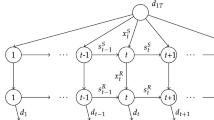Abstract
We consider a two-echelon supply chain involving one manufacturer and one supplier who collaborate on improving both design and conformance quality. Design quality is supposed to increase product desirability, and therefore market demand, while conformance quality should reduce the proportion of defective items, and therefore increase the manufacturer’s sales revenue. We investigate how the supply chain parties allocate effort between design and conformance quality under both cooperative and non-cooperative settings in an intertemporal framework. Furthermore, we evaluate wholesale price contracts and revenue-sharing contracts in terms of their performance and coordination power. We show that although a revenue-sharing contract enables the manufacturer to effectively involve the supplier in quality improvement, neither contract type allows for perfect coordination resulting in the quality that can be achieved by a cooperative supply chain. We thus suggest a reward-based extension to the revenue-sharing contract, to ensure system-wide optimal quality performance. Importantly, we find that the supplier would be better off adopting a reward-based revenue sharing contract and refusing a standard revenue-sharing contract, while the opposite would be true for the manufacturer.









Similar content being viewed by others
Notes
Cf. the recent cases of Airbus 380 plane with defective Rolls Royce engines, and Toyota cars with defective CTS accelerator pedal. Beyond design quality, these examples emphasize the need for closer collaboration between manufacturers and suppliers also on conformance quality.
References
Bresnahan, T. F., & Reiss, P. C. (1985). Dealer and manufacturer margins. The Rand Journal of Economics, 16, 253–268.
Cachon, G. (2003). Supply chain coordination with contracts. In S. Graves & T. de Kok (Eds.), Handbooks in operations research and management science: supply chain management. Amsterdam: Elsevier.
Cachon, G. P., & Lariviere, M. A. (2005). Supply chain coordination with revenue sharing contracts: strengths and limitations. Management Science, 51, 30–44.
Chand, S., Moskowitz, H., Novak, A., Rekhi, I., & Sorger, G. (1996). Capacity allocation for dynamic process improvement with quality and demand considerations. Operations Research, 44, 964–975.
Dana, J., & Spier, K. (2001). Revenue sharing and vertical control in the video rental industry. Journal of Industrial Economics, 59, 223–245.
Dockner, E., Jørgensen, S., Van Long, N., & Sorger, G. (2000). Differential games in economics and management science. Cambridge: Cambridge University Press.
Economides, N. (1999). Quality choice and vertical integration. International Journal of Industrial Organization, 17, 903–914.
El Ouardighi, F., Jørgensen, S., & Pasin, F. (2008). A dynamic game model of operations and marketing management in a supply chain. International Game Theory Review, 10, 373–397.
El Ouardighi, F., Jørgensen, S., & Pasin, F. (2012). A dynamic game with monopolist manufacturer and price-competing duopolist retailers. OR-Spectrum. doi:10.1007/s00291-012-0300-9.
El Ouardighi, F., & Kim, B. (2010). Supply quality management with wholesale price and revenue-sharing contracts under horizontal competition. European Journal of Operational Research, 206, 329–340.
Garvin, D. (1988). Managing quality. New York: Free Press.
Golany, B., & Rothblum, U. G. (2006). Inducing coordination in supply chains through linear reward schemes. Naval Research Logistics, 53, 1–15.
Hoffman, K., West, C., Westley, K., & Jarvis, S. (2005). Opportunities and challenges for the international development community and big business. The Shell Foundation Report.
Kim, B., & El Ouardighi, F. (2007). Supplier-manufacturer collaboration on new product development. In S. Jørgensen, T. Vincent, & M. Quincampoix (Eds.), Advances in dynamic games and applications to ecology and economics, Boston: Birkhauser.
Kogan, K., & Tapiero, C. S. (2007). Supply chain games: operations management and risk valuation. New York: Springer.
Mukhopadhyay, S. K., & Kouvelis, P. (1997). A differential game theoretic model for duopolistic competition on design quality. Operations Research, 45, 886–893.
Starbird, S. A. (2003). Effect of coordinated replenishment policies on quality. Journal of the Operational Research Society, 54, 32–39.
Tapiero, C. S. (2001). Yield and control in a supplier-customer relationship. International Journal of Production Research, 39, 1505–1515.
Tapiero, C. S., & Kogan, K. (2007). Risk and quality control in a supply chain: competitive and collaborative approaches. Journal of the Operational Research Society, 58, 1440–1448.
Zhu, Y., Jianxin, Y., Alard, R., & Schönsleben, P. (2009). Design quality: a key to improve product quality in international production network. Production Planning & Control, 20, 168–177.
Author information
Authors and Affiliations
Corresponding author
Rights and permissions
About this article
Cite this article
El Ouardighi, F., Kogan, K. Dynamic conformance and design quality in a supply chain: an assessment of contracts’ coordinating power. Ann Oper Res 211, 137–166 (2013). https://doi.org/10.1007/s10479-013-1414-4
Published:
Issue Date:
DOI: https://doi.org/10.1007/s10479-013-1414-4




